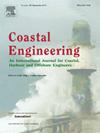Physical processes explaining the second force peak generated during a surge impact on a vertical wall
IF 4.5
2区 工程技术
Q1 ENGINEERING, CIVIL
引用次数: 0
Abstract
This paper presents an in-depth study of the impact of a surge on a vertical wall using incompressible and compressible RANS model simulations of a classical dam break experiment over a dry bed. The model allows access to the detailed flow structure and pressure field at any instant, which provides valuable complementary information to measurements. Our study focuses on the second force peak, which is often the largest one and for which the literature does not really provide a clear explanation. Before and after this peak, the pressure on the wall is governed by the flow kinematics in the area. Before the peak, an overpressure appears at the root of the reflected jet, corresponding to the violent interaction between the incoming surge and the run-down flow. At the peak instant, the situation suddenly changes, due to the collapse of the reflected jet onto the incoming flow, trapping an air cavity. As in the classical case of direct wave impact on a wall with a trapped air pocket, this process generates an additional strong uniform pressure field in the air cavity, which propagates to the water and nearby boundaries due to the water confinement effect. This compressible effect, which varies depending on the capacity of air to escape the cavity, explains the formation of the second force peak. Finally, the 3D incompressible model provides a much more reliable estimate of the second force peak than the 2D incompressible model. This is likely due to the air escape phenomenon, which occurs when the experimental initial conditions are not perfectly 2D. Although it is unlikely that the 3D simulation perfectly reproduces the experimental flow, nevertheless, with more or less comparable air escape, the computation results appear consistent.
解释在冲击垂直壁面时产生的第二个力峰值的物理过程
本文利用经典的干河床溃坝试验的不可压缩和可压缩RANS模型模拟,深入研究了浪涌对垂直壁面的影响。该模型可以在任何时刻获得详细的流动结构和压力场,为测量提供有价值的补充信息。我们的研究重点是第二个力峰,这通常是最大的一个,文献并没有真正提供一个明确的解释。在此峰值前后,壁面上的压力由区域内的流动运动学决定。在峰值之前,在反射射流的根部出现超压,这与进入的浪涌和下降流之间的剧烈相互作用相对应。在峰值时刻,情况突然发生了变化,因为反射的射流在进入的气流上坍塌,困住了一个空腔。与经典的波直接撞击带有困气穴的壁面的情况一样,这一过程在空腔中产生了一个额外的强均匀压力场,由于水的约束效应,该压力场传播到水和附近的边界。这种可压缩效应的变化取决于空气从空腔中逸出的能力,这解释了第二个力峰的形成。最后,三维不可压缩模型提供了一个比二维不可压缩模型更可靠的估计第二个力峰值。这可能是由于当实验初始条件不是完美的二维时发生的空气逃逸现象。虽然三维模拟不可能完美地再现实验流,但是,与或多或少相似的空气逸出,计算结果似乎是一致的。
本文章由计算机程序翻译,如有差异,请以英文原文为准。
求助全文
约1分钟内获得全文
求助全文
来源期刊

Coastal Engineering
工程技术-工程:大洋
CiteScore
9.20
自引率
13.60%
发文量
0
审稿时长
3.5 months
期刊介绍:
Coastal Engineering is an international medium for coastal engineers and scientists. Combining practical applications with modern technological and scientific approaches, such as mathematical and numerical modelling, laboratory and field observations and experiments, it publishes fundamental studies as well as case studies on the following aspects of coastal, harbour and offshore engineering: waves, currents and sediment transport; coastal, estuarine and offshore morphology; technical and functional design of coastal and harbour structures; morphological and environmental impact of coastal, harbour and offshore structures.
 求助内容:
求助内容: 应助结果提醒方式:
应助结果提醒方式:


